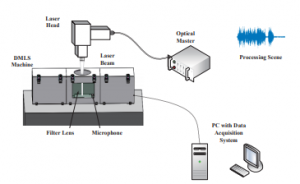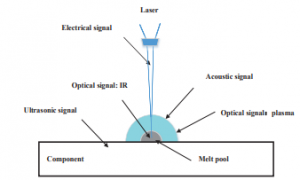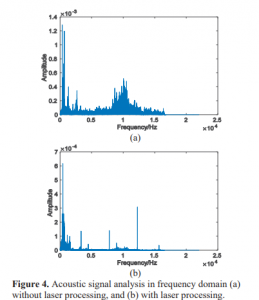SmarTech Analyzes the Metal Service Bureau Business in New Report
Leading industry analysis firm, SmarTech, just published a report on emerging metal printing opportunities for 3DP service bureaus. The new report, Metal 3D Printing Services: Service Revenues, Printer Purchases, and Materials Consumption – 2018 To 2027, contains corporate profiles (showing how leading service bureaus are taking advantage of metal printing), and granular 10-year forecasts, with break outs by industry verticals, types of metal, type of printers/3DP processes, uses and types of metals printed.

This report is the first from a new group at SmarTech which is focusing on service bureau opportunities. The SmarTech team is currently at work building a comprehensive forecasting model for service bureau revenues, printer purchases, install base, and materials consumption. This work will be based on the many studies of industry verticals for 3D printing undertaken by SmarTech over the past six years.
Metals 3DP and Service Bureaus: A Dilemma
Lawrence Gasman, President of SmarTech and author of the study, says that metal printing by service bureaus alone will generate $6.7 billion in revenues by 2023. According to Gasman, metals printing will be especially important to service bureaus. “Metals printing is more complex and harder for end-users to take ‘in house’ than polymer printing,” says Gasman, “but SmarTech’s research indicates that metal printing may be less profitable than polymer printing for bureaus. This is the paradox. From the service bureau perspective, metals printing may be where the growth is, but at the same time bureaus focusing more on metals could find their profit margins eroded.”
The new SmarTech report discusses ways around this dilemma including specialization in certain market verticals or in certain metals. However, it concludes that sustainable competitive advantage in the metals service bureau will come from two strategic approaches. One of these involves “hub networks” that distribute the responsibility for printing metals jobs booked by the hub company to many service bureaus based on geography, capacity, and technical capabilities. “Using proprietary software, hub networks can create efficiencies that can offset lower margins on printing metal products,” says Gasman. The SmarTech report also notes that making the actual metal printing part of a higher value-added offering that includes design and technical guidance will also be an important strategic route to profitable success for metal service bureau.
Medical, Dental and Metal
In addition to the usual suspects (automotive, aerospace, oil and gas), SmarTech reports that metal printing by service bureaus are expected to generate considerable revenues from the medical and dental sectors. While, much medical 3DP is polymer-based, there are important exceptions. Metal implants are mostly Ti64, commercially pure titanium or cobalt chrome alloys such as MP1.

Titanium alloys are the go-to implant material for orthopedic implants providing lightweight, biological inertness, and the ability to function as a load bearing implant. But despite the criticality of these materials, printing of these (and other) metal implants with PBF simply cannot be done in primary care environments due to requirements for safe handling of reactive materials, post-processing and post heat treatment requirements, and testing. And even though there is a general trend towards bringing medical/dental care closer to the patient, the fact that printing metals is not an easy thing to do will make this trend a slowly acting one.
This provides some advantage to metals service bureaus. “What we are seeing,” says SmarTech’s Gasman, “is that while some of the larger medical device leaders have begun investing more heavily in the internal production of additively manufactured implants, OEMs remain significantly focused on outsourcing to service bureaus in order to focus down on core competencies and R&D. However, bureaus planning to exploit this particular opportunity will have to acquire a high degree of specialization and process expertise.”

Meanwhile, in the dental sector, the equivalent of service bureau (confusingly still called milling centers), the 3D printing of metals is focused on producing metallic elements for porcelain-fused-to-metal (PFM) dental restorations and the metal hardware for dental implants (including the screw and the abutment to which the visible tooth-like portion of the implant is affixed). By 2023, SmarTech believes that over half service bureau revenues associated with metal printing will come from printing dental or medical products. Conversely, print services are expected to drive a majority share of total opportunities associated with medical and dental 3D printing in general.
The new SmarTech report on metal service bureaus is available now for purchase at Smart Tech Publishing here. For more details on this report contact Rob Nolan at rob@smartechpublishing.com
3DPrint.com is an equity holder of Smartech Publishing.
Acoustics Play a Role in Determining 3D Print Quality
 Metal 3D printing is constantly under study to improve its quality and repeatability. A new research paper focuses on direct metal laser sintering (DMLS), also known as selective laser melting (SLM) and Powder Bed Fusion for Metal. DMLS still has its shortcomings, which include delamination between base plates and inaccuracy among various orientations. The paper, entitled “Characterization of acoustic signals during a direct metal laser sintering process,” points out that sintered parts tend to still be relatively large, soft and porous, hampering their widespread use, so improving part quality and repetability is crucial, especially for industries like aerospace and medicine.
Metal 3D printing is constantly under study to improve its quality and repeatability. A new research paper focuses on direct metal laser sintering (DMLS), also known as selective laser melting (SLM) and Powder Bed Fusion for Metal. DMLS still has its shortcomings, which include delamination between base plates and inaccuracy among various orientations. The paper, entitled “Characterization of acoustic signals during a direct metal laser sintering process,” points out that sintered parts tend to still be relatively large, soft and porous, hampering their widespread use, so improving part quality and repetability is crucial, especially for industries like aerospace and medicine.
The researchers look at acoustic signal processing as a way to monitor the build quality of a 3D printed part while in progress.
“This paper reports the relationship between acoustic signals, laser power as well as its laser scanning speed,” the researchers state. “The variety of acoustic signal power spectrum density (PSD) is presented and then the mechanism of acoustic signal formation is elaborated. A good mapping between acoustic signals and laser parameters has been found during the DMLS process. This lays a good foundation for monitoring the process and quality by acoustic signal and will enhance the part quality during the powder-based laser sintering and melting processes in the future.”
 Several methods of in-process monitoring exist, such as optical, thermal, ultrasound and acoustic signals. Each has its drawbacks, but acoustic signals have been found to be an effective method as long as they are not disrupted by environmental noise. In this study, acoustic signals generated during the DMLS process were sampled and utilized for online monitoring.
Several methods of in-process monitoring exist, such as optical, thermal, ultrasound and acoustic signals. Each has its drawbacks, but acoustic signals have been found to be an effective method as long as they are not disrupted by environmental noise. In this study, acoustic signals generated during the DMLS process were sampled and utilized for online monitoring.
Acoustic signals in a DMLS process are generated by several factors, mostly by the vibration from the friction of flow medium with liquid or solid matter, as well as flow motion. The signals in this study were sampled by an electret condenser microphone and processed with MATLAB 2015b.
The results of the experiment showed that there was a good correlation between the laser frequency and laser power as well as the laser scanning speed and acoustic signals.
“Through the investigation of the acoustic signal, information on the laser scanning characteristics can be extracted,” the researchers explain. “The second frequency peak is more promising for detecting the laser scanning attributes.”
 The study showed that there was a good mapping between the acoustic signals and laser scanning status as well as the resulting laser sintering quality. These results, according to the researchers, will lead to future monitoring techniques for DMLS and provide a strong foundation for real-time control of metal printing processes.
The study showed that there was a good mapping between the acoustic signals and laser scanning status as well as the resulting laser sintering quality. These results, according to the researchers, will lead to future monitoring techniques for DMLS and provide a strong foundation for real-time control of metal printing processes.
“Future studies will be carried out on part qualities such as surface roughness, porosity, density and composition of the powder mixture interpreted via acoustic signals,” they conclude. “Defects can be predicted automatically for quality monitoring and feedback control.”
Studies like this one are important steps toward understanding what is happening during the metal 3D printing process, so that defects can be caught and avoided. Metal 3D printing is far from a perfect process, but the more technology is applied to understanding it, the more effective it will be.
Authors of the paper include Dongsen Ye, Yingjie Zhang, Kunpeng Zhu, Geok Soon Hong and Jerry Fuh Ying His.
Discuss this and other 3D printing topics at 3DPrintBoard.com or share your thoughts below.
